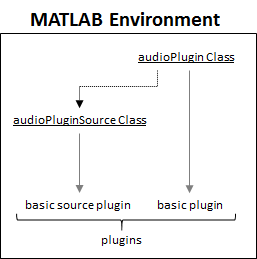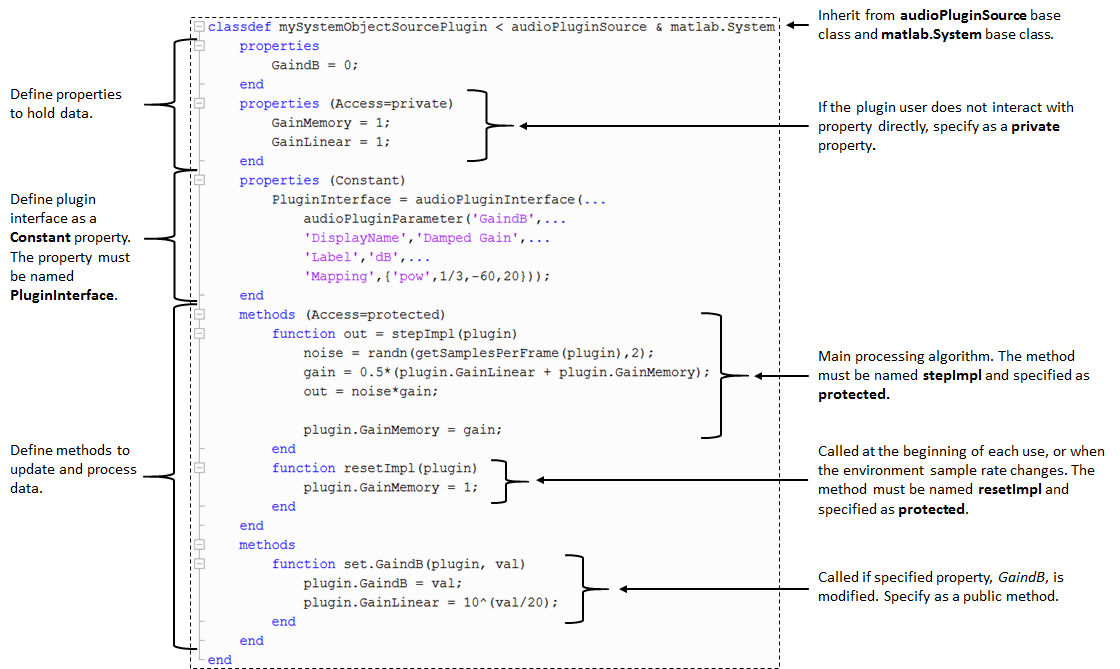Audio Plugins in MATLAB
Role of Audio Plugins in Audio Toolbox
The audio plugin is the suggested paradigm for developing your audio processing algorithm in Audio Toolbox™. Once designed, the audio plugin can be validated, generated, and deployed to a third-party digital audio workstation (DAW).
Additional benefits of developing your audio processing as an audio plugin include:
Rapid prototyping using the Audio Test Bench
Integration with MIDI devices
Code reuse
Some understanding of object-oriented programming (OOP) in the MATLAB® environment is required to optimize your use of the audio plugin paradigm. If you are unfamiliar with these concepts, see Why Use Object-Oriented Design.
For a review of audio plugins as defined outside the MATLAB environment, see What Are DAWs, Audio Plugins, and MIDI Controllers?
Defining Audio Plugins in the MATLAB Environment
In the MATLAB environment, an audio
plugin refers to a class derived from the audioPlugin base class or the audioPluginSource base class.

Audio Toolbox documentation uses the following terminology:
A plugin is any audio plugin that derives from the
audioPluginclass or theaudioPluginSourceclass.A basic plugin is an audio plugin that derives from the
audioPluginclass.A basic source plugin is an audio plugin that derives from the
audioPluginSourceclass.
Audio plugins can also inherit from matlab.System. Any object that derives from matlab.System is referred to as a System object™. Deriving from matlab.System allows
for additional functionality, including Simulink® integration. However, manipulating System objects requires a more
advanced understanding of OOP in the MATLAB environment.
See Audio Toolbox Extended Terminology for a detailed visualization of inheritance and terminology.
Design a Basic Plugin
In this example, you create a simple plugin, and then gradually increase complexity. Your final plugin uses a circular buffer to add an echo effect to an input audio signal. For additional considerations for generating a plugin, see Export a MATLAB Plugin to a DAW.
Define a Basic Plugin Class. Begin with a simple plugin that copies input to output without modification.
classdef myEchoPlugin < audioPlugin methods function out = process(~, in) out = in; end end end
myEchoPluginillustrates the two minimum requirements for audio plugin classes. They must:Inherit from
audioPluginclassHave a
processmethod
The
processmethod contains the primary frame-based audio processing algorithm. It is called in an audio stream loop to process an audio signal over time.By default, both the input to and output from the
processmethod have two channels (columns). The number of input rows (frame size) passed toprocessis determined by the environment in which it is run. The output must have the same number of rows as the input.Add a Plugin Property. A property can store information in an object. Add a property,
Gain, to your class definition. Modify yourprocessmethod to multiply the input by the value specified by theGainproperty.The first argument of the
processmethod has changed from~toplugin. The first argument ofprocessis reserved for the audio plugin object.Add a Plugin Parameter. Plugin parameters are the interface between plugin properties and the plugin user. The definition of this interface is handled by
audioPluginInterface, which holdsaudioPluginParameterobjects. To associate a plugin property to a parameter, specify the first argument ofaudioPluginParameteras a character vector entered exactly as the property you want to associate. The remaining arguments ofaudioPluginParameterspecify optional additional parameter attributes.In this example, you specify a mapping between the value of the parameter and its associated property, as well as the parameter display name as it appears on a plugin dialog box. By specifying
'Mapping'as{'lin',0,3}, you set a linear mapping between theGainproperty and the associated user-facing parameter, with an allowable range for the property between 0 and 3.Add Private Properties. Add properties to store a circular buffer, a buffer index, and the N-sample delay of your echo. Because the plugin user does not need to see them, make
CircularBuffer,BufferIndex, andNSamplesprivate properties. It is best practice to initialize properties to their type and size.Add an Echo. In the
processmethod, write to and read from your circular buffer to create an output that consists of your input and a gain-adjusted echo. The first line of theprocessmethod initializes the output to the size of the input. It is best practice to initialize your output to avoid errors when generating plugins.Make the Echo Delay Tunable. To allow the user to modify the
NSamplesdelay of the echo, define a public property,Delay, and associate it with a parameter. Use the defaultaudioPluginParametermapping to allow the user to set the echo delay between 0 and 1 seconds.Add a
setmethod that listens for changes to theDelayproperty. Use thegetSampleRatemethod of theaudioPluginbase class to return the environment sample rate. Approximate a delay specified in seconds as a number of samples,NSamples. If the plugin user modifies theDelayproperty,set.Delayis called and the delay in samples (NSamples) is calculated. If the environment sample rate is above 192,000 Hz, the plugin does not perform as expected.Add a Reset Function. The
resetmethod of a plugin contains instructions to reset the plugin between uses or when the environment sample rate changes. BecauseNSamplesdepends on the environment sample rate, update its value in theresetmethod.
Design a System Object Plugin
You can map the basic plugin to a System object plugin. Note the differences between the two plugin types:
A System object plugin inherits from both the
audioPluginbase class and thematlab.Systembase class, not justaudioPluginbase class.The primary audio processing method of a System object plugin is named
stepImpl, notprocess.The reset method of a System object is named
resetImpl, notreset.Both
resetImplandstepImplmust be defined as protected methods.System objects enable alternatives to the
setmethod. For more information, seeprocessTunedPropertiesImpl.
Quick Start Basic Plugin
Quick Start Basic Source Plugin
Quick Start System Object Plugin
Quick Start System Object Source Plugin
Audio Toolbox Extended Terminology
In the MATLAB environment, an audio plugin refers to a class derived from the
audioPlugin base class or the audioPluginSource base class. Audio plugins can also
inherit from matlab.System. Any object that
derives from matlab.System is referred to as a
System object. Deriving from matlab.System allows
for additional functionality, including Simulink integration. However, manipulating System objects requires a more
advanced understanding of OOP in the MATLAB environment.





